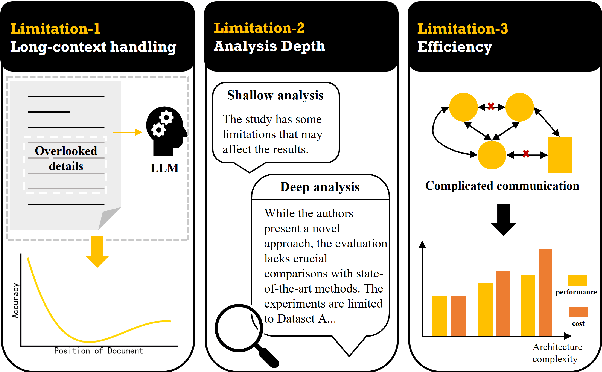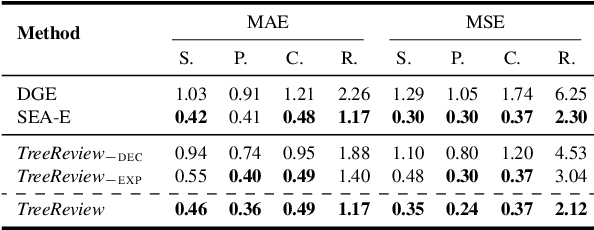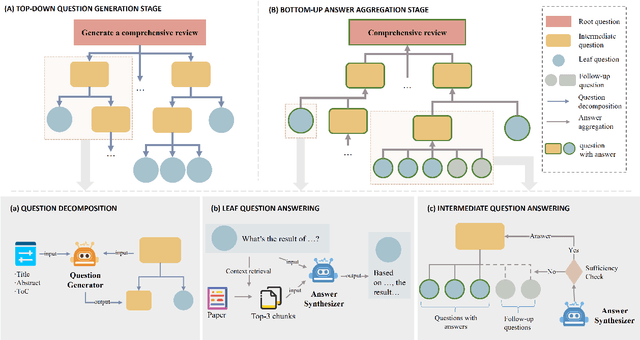Ziyue Li
GTR-Bench: Evaluating Geo-Temporal Reasoning in Vision-Language Models
Oct 09, 2025Abstract:Recently spatial-temporal intelligence of Visual-Language Models (VLMs) has attracted much attention due to its importance for Autonomous Driving, Embodied AI and General Artificial Intelligence. Existing spatial-temporal benchmarks mainly focus on egocentric perspective reasoning with images/video context, or geographic perspective reasoning with graphics context (eg. a map), thus fail to assess VLMs' geographic spatial-temporal intelligence with both images/video and graphics context, which is important for areas like traffic management and emergency response. To address the gaps, we introduce Geo-Temporal Reasoning benchmark (GTR-Bench), a novel challenge for geographic temporal reasoning of moving targets in a large-scale camera network. GTR-Bench is more challenging as it requires multiple perspective switches between maps and videos, joint reasoning across multiple videos with non-overlapping fields of view, and inference over spatial-temporal regions that are unobserved by any video context. Evaluations of more than 10 popular VLMs on GTR-Bench demonstrate that even the best proprietary model, Gemini-2.5-Pro (34.9%), significantly lags behind human performance (78.61%) on geo-temporal reasoning. Moreover, our comprehensive analysis on GTR-Bench reveals three primary deficiencies of current models for geo-temporal reasoning. (1) VLMs' reasoning is impaired by an imbalanced utilization of spatial-temporal context. (2) VLMs are weak in temporal forecasting, which leads to worse performance on temporal-emphasized tasks than on spatial-emphasized tasks. (3) VLMs lack the proficiency to comprehend or align the map data with multi-view video inputs. We believe GTR-Bench offers valuable insights and opens up new opportunities for research and applications in spatial-temporal intelligence. Benchmark and code will be released at https://github.com/X-Luffy/GTR-Bench.
Language-Instructed Reasoning for Group Activity Detection via Multimodal Large Language Model
Sep 19, 2025Abstract:Group activity detection (GAD) aims to simultaneously identify group members and categorize their collective activities within video sequences. Existing deep learning-based methods develop specialized architectures (e.g., transformer networks) to model the dynamics of individual roles and semantic dependencies between individuals and groups. However, they rely solely on implicit pattern recognition from visual features and struggle with contextual reasoning and explainability. In this work, we propose LIR-GAD, a novel framework of language-instructed reasoning for GAD via Multimodal Large Language Model (MLLM). Our approach expand the original vocabulary of MLLM by introducing an activity-level <ACT> token and multiple cluster-specific <GROUP> tokens. We process video frames alongside two specially designed tokens and language instructions, which are then integrated into the MLLM. The pretrained commonsense knowledge embedded in the MLLM enables the <ACT> token and <GROUP> tokens to effectively capture the semantic information of collective activities and learn distinct representational features of different groups, respectively. Also, we introduce a multi-label classification loss to further enhance the <ACT> token's ability to learn discriminative semantic representations. Then, we design a Multimodal Dual-Alignment Fusion (MDAF) module that integrates MLLM's hidden embeddings corresponding to the designed tokens with visual features, significantly enhancing the performance of GAD. Both quantitative and qualitative experiments demonstrate the superior performance of our proposed method in GAD taks.
Fishing for Answers: Exploring One-shot vs. Iterative Retrieval Strategies for Retrieval Augmented Generation
Sep 05, 2025Abstract:Retrieval-Augmented Generation (RAG) based on Large Language Models (LLMs) is a powerful solution to understand and query the industry's closed-source documents. However, basic RAG often struggles with complex QA tasks in legal and regulatory domains, particularly when dealing with numerous government documents. The top-$k$ strategy frequently misses golden chunks, leading to incomplete or inaccurate answers. To address these retrieval bottlenecks, we explore two strategies to improve evidence coverage and answer quality. The first is a One-SHOT retrieval method that adaptively selects chunks based on a token budget, allowing as much relevant content as possible to be included within the model's context window. Additionally, we design modules to further filter and refine the chunks. The second is an iterative retrieval strategy built on a Reasoning Agentic RAG framework, where a reasoning LLM dynamically issues search queries, evaluates retrieved results, and progressively refines the context over multiple turns. We identify query drift and retrieval laziness issues and further design two modules to tackle them. Through extensive experiments on a dataset of government documents, we aim to offer practical insights and guidance for real-world applications in legal and regulatory domains.
HiPlan: Hierarchical Planning for LLM-Based Agents with Adaptive Global-Local Guidance
Aug 26, 2025Abstract:Large language model (LLM)-based agents have demonstrated remarkable capabilities in decision-making tasks, but struggle significantly with complex, long-horizon planning scenarios. This arises from their lack of macroscopic guidance, causing disorientation and failures in complex tasks, as well as insufficient continuous oversight during execution, rendering them unresponsive to environmental changes and prone to deviations. To tackle these challenges, we introduce HiPlan, a hierarchical planning framework that provides adaptive global-local guidance to boost LLM-based agents'decision-making. HiPlan decomposes complex tasks into milestone action guides for general direction and step-wise hints for detailed actions. During the offline phase, we construct a milestone library from expert demonstrations, enabling structured experience reuse by retrieving semantically similar tasks and milestones. In the execution phase, trajectory segments from past milestones are dynamically adapted to generate step-wise hints that align current observations with the milestone objectives, bridging gaps and correcting deviations. Extensive experiments across two challenging benchmarks demonstrate that HiPlan substantially outperforms strong baselines, and ablation studies validate the complementary benefits of its hierarchical components.
Skip a Layer or Loop it? Test-Time Depth Adaptation of Pretrained LLMs
Jul 10, 2025Abstract:Can a pretrained neural network adapt its architecture to different inputs without any finetuning? Do we need all layers for simple tasks, and are they adequate for challenging tasks? We found that the layers of a pretrained large language model (LLM) can be manipulated as separate modules to build a better and even shallower model customized for each test sample. In particular, each layer from the pretrained model can be skipped/pruned or repeated multiple times as recurrent neural networks (RNN), and stacked with others in arbitrary orders, yielding a chain-of-layers (CoLa) per sample. This compositional space greatly expands the scope of existing works on looped/recurrent pretrained modules, layer pruning, or early-exit networks. We develop a Monte Carlo Tree Search (MCTS) protocol to explore and identify the optimal CoLa for each sample from math and commonsense reasoning benchmarks. Compared to a static model of a fixed depth, CoLa allows shortcut paths (fast thinking), recurrence of the same layer(s) (slow thinking), and combining both, offering more flexible, dynamic architectures for different inputs. We conduct an extensive analysis of the MCTS-optimized CoLa, which leads to two key findings: (1) For >75% of samples with correct predictions by the original LLM, we can find shorter CoLa, suggesting a large space for improving inference efficiency; (2) For >60% of samples with originally incorrect predictions, we can identify CoLa achieving correct predictions, suggesting a large space of performance enhancement. Our results highlight the shortcomings of using a fixed architecture of pre-trained LLMs for inference on different samples and pave the way to unlock the generalization power of test-time depth adaptation.
Where to find Grokking in LLM Pretraining? Monitor Memorization-to-Generalization without Test
Jun 26, 2025Abstract:Grokking, i.e., test performance keeps improving long after training loss converged, has been recently witnessed in neural network training, making the mechanism of generalization and other emerging capabilities such as reasoning mysterious. While prior studies usually train small models on a few toy or highly-specific tasks for thousands of epochs, we conduct the first study of grokking on checkpoints during one-pass pretraining of a 7B large language model (LLM), i.e., OLMoE. We compute the training loss and evaluate generalization on diverse benchmark tasks, including math reasoning, code generation, and commonsense/domain-specific knowledge retrieval tasks. Our study, for the first time, verifies that grokking still happens in the pretraining of large-scale foundation models, though different data may enter grokking stages asynchronously. We further demystify grokking's "emergence of generalization" by investigating LLM internal dynamics. Specifically, we find that training samples' pathways (i.e., expert choices across layers) evolve from random, instance-specific to more structured and shareable between samples during grokking. Also, the complexity of a sample's pathway reduces despite the converged loss. These indicate a memorization-to-generalization conversion, providing a mechanistic explanation of delayed generalization. In the study, we develop two novel metrics to quantify pathway distance and the complexity of a single pathway. We show their ability to predict the generalization improvement on diverse downstream tasks. They are efficient, simple to compute and solely dependent on training data. Hence, they have practical value for pretraining, enabling us to monitor the generalization performance without finetuning and test. Theoretically, we show that more structured pathways reduce model complexity and improve the generalization bound.
GuiLoMo: Allocating Expert Number and Rank for LoRA-MoE via Bilevel Optimization with GuidedSelection Vectors
Jun 17, 2025Abstract:Parameter-efficient fine-tuning (PEFT) methods, particularly Low-Rank Adaptation (LoRA), offer an efficient way to adapt large language models with reduced computational costs. However, their performance is limited by the small number of trainable parameters. Recent work combines LoRA with the Mixture-of-Experts (MoE), i.e., LoRA-MoE, to enhance capacity, but two limitations remain in hindering the full exploitation of its potential: 1) the influence of downstream tasks when assigning expert numbers, and 2) the uniform rank assignment across all LoRA experts, which restricts representational diversity. To mitigate these gaps, we propose GuiLoMo, a fine-grained layer-wise expert numbers and ranks allocation strategy with GuidedSelection Vectors (GSVs). GSVs are learned via a prior bilevel optimization process to capture both model- and task-specific needs, and are then used to allocate optimal expert numbers and ranks. Experiments on three backbone models across diverse benchmarks show that GuiLoMo consistently achieves superior or comparable performance to all baselines. Further analysis offers key insights into how expert numbers and ranks vary across layers and tasks, highlighting the benefits of adaptive expert configuration. Our code is available at https://github.com/Liar406/Gui-LoMo.git.
Reasoning RAG via System 1 or System 2: A Survey on Reasoning Agentic Retrieval-Augmented Generation for Industry Challenges
Jun 12, 2025Abstract:Retrieval-Augmented Generation (RAG) has emerged as a powerful framework to overcome the knowledge limitations of Large Language Models (LLMs) by integrating external retrieval with language generation. While early RAG systems based on static pipelines have shown effectiveness in well-structured tasks, they struggle in real-world scenarios requiring complex reasoning, dynamic retrieval, and multi-modal integration. To address these challenges, the field has shifted toward Reasoning Agentic RAG, a paradigm that embeds decision-making and adaptive tool use directly into the retrieval process. In this paper, we present a comprehensive review of Reasoning Agentic RAG methods, categorizing them into two primary systems: predefined reasoning, which follows fixed modular pipelines to boost reasoning, and agentic reasoning, where the model autonomously orchestrates tool interaction during inference. We analyze representative techniques under both paradigms, covering architectural design, reasoning strategies, and tool coordination. Finally, we discuss key research challenges and propose future directions to advance the flexibility, robustness, and applicability of reasoning agentic RAG systems. Our collection of the relevant research has been organized into a https://github.com/ByebyeMonica/Reasoning-Agentic-RAG.
TreeReview: A Dynamic Tree of Questions Framework for Deep and Efficient LLM-based Scientific Peer Review
Jun 09, 2025



Abstract:While Large Language Models (LLMs) have shown significant potential in assisting peer review, current methods often struggle to generate thorough and insightful reviews while maintaining efficiency. In this paper, we propose TreeReview, a novel framework that models paper review as a hierarchical and bidirectional question-answering process. TreeReview first constructs a tree of review questions by recursively decomposing high-level questions into fine-grained sub-questions and then resolves the question tree by iteratively aggregating answers from leaf to root to get the final review. Crucially, we incorporate a dynamic question expansion mechanism to enable deeper probing by generating follow-up questions when needed. We construct a benchmark derived from ICLR and NeurIPS venues to evaluate our method on full review generation and actionable feedback comments generation tasks. Experimental results of both LLM-based and human evaluation show that TreeReview outperforms strong baselines in providing comprehensive, in-depth, and expert-aligned review feedback, while reducing LLM token usage by up to 80% compared to computationally intensive approaches. Our code and benchmark dataset are available at https://github.com/YuanChang98/tree-review.
Unlocking the Power of SAM 2 for Few-Shot Segmentation
May 21, 2025



Abstract:Few-Shot Segmentation (FSS) aims to learn class-agnostic segmentation on few classes to segment arbitrary classes, but at the risk of overfitting. To address this, some methods use the well-learned knowledge of foundation models (e.g., SAM) to simplify the learning process. Recently, SAM 2 has extended SAM by supporting video segmentation, whose class-agnostic matching ability is useful to FSS. A simple idea is to encode support foreground (FG) features as memory, with which query FG features are matched and fused. Unfortunately, the FG objects in different frames of SAM 2's video data are always the same identity, while those in FSS are different identities, i.e., the matching step is incompatible. Therefore, we design Pseudo Prompt Generator to encode pseudo query memory, matching with query features in a compatible way. However, the memories can never be as accurate as the real ones, i.e., they are likely to contain incomplete query FG, and some unexpected query background (BG) features, leading to wrong segmentation. Hence, we further design Iterative Memory Refinement to fuse more query FG features into the memory, and devise a Support-Calibrated Memory Attention to suppress the unexpected query BG features in memory. Extensive experiments have been conducted on PASCAL-5$^i$ and COCO-20$^i$ to validate the effectiveness of our design, e.g., the 1-shot mIoU can be 4.2% better than the best baseline.
 Add to Chrome
Add to Chrome Add to Firefox
Add to Firefox Add to Edge
Add to Edge